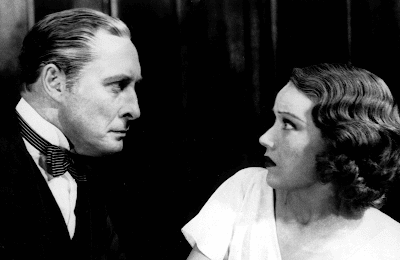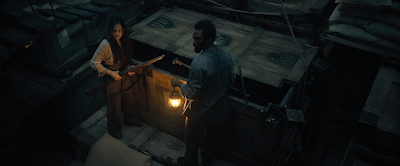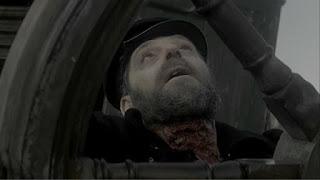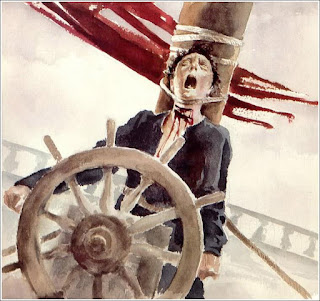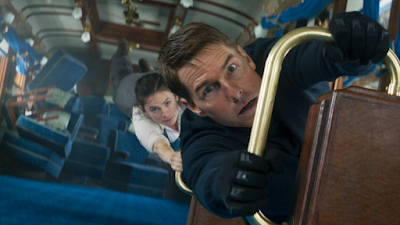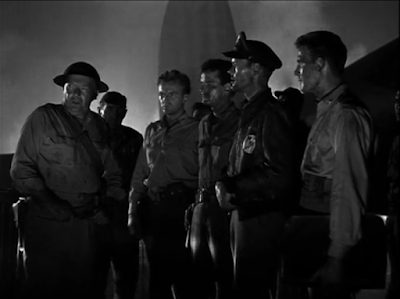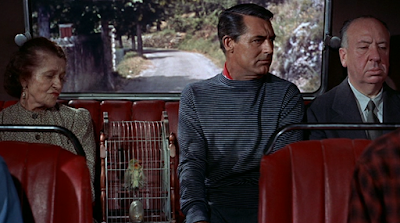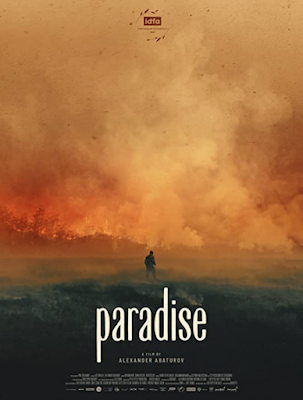Arsenic and Old Lace (1944, directed by Frank Capra) is probably the most divisive film in Cary Grant's filmography. It is perennially popular among fans of old movies, among fans of Cary Grant, and among fans of what I can only describe as "cozy horror." Many other viewers, including the actor himself, don't much like it. Grant thought his performance was among his worst. Some viewers don't care for Frank Capra's brand of corny, though I would argue that this is a different kind of corn than the director usually served up. There is a category of viewer who dislikes the film not for what it contains, but for what it left out. Let me explain: Arsenic and Old Lace was a huge success on Broadway. Most of the Broadway cast reprised their roles in the movie version, with the conspicuous exception of Boris Karloff. Karloff played the criminal, Jonathan Brewster, the film's villain. The script mentions Karloff by name in describing Jonathan Brewster. That the role was played by Karloff himself is one of the play's best jokes. Karloff had a financial stake in the play, so rather than abandon the production for a piecework paycheck in the film version, he remained in New York for a more lucrative and extended paycheck. His part in the film was filled with Raymond Massey, but the Boris Karloff joke remains, with Karloff's blessing. The film was shot in 1941 with the stipulation that it couldn't be released until the play closed. The play ran for three years, much to the consternation of Warner Brothers. Karloff backed the right horse.*
"The fool, the meddling idiot! As though her ape's brain
could contain the secrets of the Krell!"
Made by a human being. AI is the death of culture.
Pages
Saturday, December 30, 2023
Saturday, November 25, 2023
A Remarkable Collection of Dopes
It's a shame that they're killers, because cigarettes used to be the most valuable prop in movies. There are whole films from the 1940s and 1950s--the heart of the cigarette century--that consist of people aggressively smoking at each other. Film noir was rife with such films. It's a miracle anyone can see the players in Laura (1944, directed by Otto Preminger) through the haze of cigarette smoke. I'm exaggerating, I suppose, but only a little. The last time I wrote about Laura, I was taken in with its doomed romanticism and with its old Hollywood elegance. This time through, I was struck by the hard-boiled wit and the queerness of it all. It's a film that repays repeat viewings, because it's one of those films that changes with the viewer.
Tuesday, November 21, 2023
Ants in the Pants
"I got ants in my pants and I need to dance!" -- James Brown
It's been a while since I've seen Them! (1954, directed by Gordon Douglas). I didn't remember how hard it goes when generating its scares. I maybe never knew that it was intended to be framed in a moderate widescreen. I don't ever remember seeing the red and blue title card. The last time I saw the film was in the 1990s, maybe? I don't honestly recall. There's a lot of water under the bridge. The two things I did remember about the film are the sound of the giant ants and the blank expression on the little girl at the beginning of the film. That blank expression is terrifying.
Sunday, November 12, 2023
You Reap What You Sow
Use every man after his desert, and who should 'scape whipping? Use them after your own honour and dignity. The less they deserve, the more merit is in your bounty.
--William Shakespeare, Hamlet
The word "pagan" derives from the latin word, "paganus/pagani," which means, literally, "peasant." Its original usage also connoted "bumpkin" or "hick," though significantly not "farmer" ("agricola"). At its most benign, it meant countryman or civilian. Its modern usage reminds us that Christianity was originally an urban religion. Wander out into the sticks if you're a good Christian, and you'll run into a bunch of bumpkins who still practice the old religions. That's the root of folk horror right there. When you combine this with an America that still occasionally dreams of itself as an agrarian society, you can see how paganism and Americana get inextricably woven together. The people out in the country may think of themselves as god-fearing Christians, but the old ways still linger. Particularly around Halloween. In Dark Harvest (2023, directed by David Slade), a Halloween-y movie if ever there was one, this gets a treatment that's equal parts nostalgia and deconstruction. Like the inhabitants of Summerisle in The Wicker Man, the farmers make a sacrifice to their crop, but they stage it as an all American tradition, like football and fast cars. It's a film that inhabits an archetype, one that would be familiar to Stephen King or Shirley Jackson or (pointedly) Ray Bradbury. It's part "Children of the Corn", part "The Lottery," part Dark Carnival. Certainly, novelist Norman Partridge knew the signposts on the back country roads he was traveling when he wrote the novel on which this is based. And so does Director David Slade.
Tuesday, October 31, 2023
Flesh of My Flesh
My first impression of Suitable Flesh (2023, directed by Joe Lynch) during its first act was that it didn't feel like a horror movie at all. It felt like one of those direct to video "erotic thrillers" of the late 1980s/early 1990s. Do you know the ones? They often starred former centerfold Shannon Tweed (who in her defense was a pretty good actress in a limited range) or Andrew Stevens. Suitable Flesh has the same shot on video look to it and the same baffling erotic impulses. I mean, sure. The film starts with an autopsy about to begin, and a psychiatrist visiting her friend and colleague after that colleague has been locked in a padded cell. And this all happens at "Miskatonic Medical School." But once that mental patient begins her story, you can queue up the candles for a night of soft-core. Or maybe not. Because this film doesn't get very naked, even if it does include oral pleasures. And once the film gets to the horror parts of the program, it goes at it full bore. It goes so over the top that I found myself giggling at two of its more outre` set-pieces. The second impression I had in its early going was that this was a film with a serious case of gender. The source material is Lovecraft's "The Thing on the Doorstep" which has as protagonists Lovecraft's usual neurasthenic male academics. This film gender swaps the leads and then mixes the novelty of female sexuality into the story's body-hopping shenanigans. Old Howard would run screaming from this, I'm sure.
Wednesday, October 25, 2023
Bats in the Belfry
The Vampire Bat (1933, directed by Frank R. Strayer) is filmmaking opportunism at its finest. Its studio, Majestic Pictures, had a reputation for turning out higher quality product than its poverty row brethren, in part because the studio had a habit of renting out the facilities of bigger studios when those facilities were idle. That's what happened here. The producers filmed great whacks of the film on the sets Universal built for Frankenstein and The Old Dark House, and borrowed a number of character actors from Universal to give it the appearance of being a new Universal production. Lionel Belmore, who played the Burgomaster in Frankenstein, plays the Bürgermeister here as if this film was set in the same universe. Dwight Frye appears here, too, and you could be forgiven for mistaking him for Renfield's imbecile cousin. It's practically the same performance. The real impetus for this film was making use of the two stars of Warner Brothers' Doctor X and The Mystery of the Wax Museum. Doctor X had been a substantial hit, and The Mystery of the Wax Museum had every indication of surpassing it. But the latter film's production took longer than expected and both Fay Wray and Lionel Atwill were idle at the time. Wray already had experience with waiting out complicated productions, having already starred in The Most Dangerous Game while the special effects for King Kong were being completed, using Kong's sets and technicians. In stepped Majestic, with a production ready to go for the two actors. Melvyn Douglas, fresh off James Whale's The Old Dark House, completed the cast. The film beat The Mystery of the Wax Museum into theaters by a little over a month, letting Warners' publicity department do the heavy lifting. Given the improvisational nature of its production, it's a miracle that the film is watchable at all. Seriously, there's no reason at all for this to have turned out to be a good movie. It's a rip off at its core. And yet...this is surprisingly entertaining. Personally, I think the secret ingredient is Melvyn Douglas. He was a talent much too large to stay confined in the horror movie. Fay Wray and Lionel Atwill (and to a lesser extent Dwight Frye) are talents too big for poverty row, too, though perhaps not too big for horror films. Fay Wray made five of them in quick succession in 1932, and they are the films for which she is best remembered. This is a film where the cast provides the alchemy that makes the movie work, which is a good thing because the script has serious deficiencies. To quote The Bard, it's a tale told by an idiot...
Tuesday, October 24, 2023
Scare-a-Thon 2023: We Have Always Lived In the Castle
Here's another edition of my friend, Aaron's, Scare-a-thon. I'm on the panel here. It's for a good cause.
There are a couple of these on the horizon, so stay tuned.

This blog is supported on Patreon by wonderful subscribers. If you like what I do, please consider pledging your own support. It means the world to me.
Friday, October 13, 2023
A Murderer's Dozen
"Stiff." That's the word for most films from the dawn of talkies. "Stilted" is a good one, too. The Thirteenth Chair (1929, directed by Tod Browning) fits both descriptions. It's a bit of an evolutionary missing link, given that it was filmed in both a silent and sound version while Hollywood was still in the process of learning how to make talkies. Many theaters at the time were still unable to even show them. The silent version is lost, alas, and I can't help but think that it's a much better film. The silents of the late 1920s were some of the glories of cinema, attaining heights of artistry it took sound pictures almost a decade to equal. This assumes you believe they ever did. I'm dubious of that very last point. This particular film is notable for two reasons. First, the lead role was offered to Lon Chaney. Had he accepted it, it would have been his last collaboration with Browning, and their only talkie before Chaney died of cancer. Chaney did not accept the part. Second, it teams Browning with Bela Lugosi for the first time and prefigures Lugosi's screen image in the films that followed Dracula. Browning ultimately made three films with Lugosi. Beyond the trivia, The Thirteenth Chair is a slog for a contemporary audience, but it's not without interest.
Sunday, October 08, 2023
The Blood is the Life
Tod Browning's Dracula (1931) is a pivotal movie in the history of horror movies. It is the first major horror film of the sound era. Without its success, the explosion of horror movies during the pre-Code era possibly doesn't happen, or, maybe, happens on a smaller scale or just differently. The movie studios of the day, big and small, were increasingly desperate for hits in 1931 as the Great Depression deepened and paying audiences evaporated. Anything that drew a crowd was all right by the heads of the studios. What drew crowds in those days was sin, salaciousness, violence, licentiousness, and sensation. Horror movies could provide all of that. The genre itself is built on transgression, after all. Moreover, the elements of what came to be defined as the Universal horror movie were already in place. Universal made big money on horror movies during the silent era. Two of Lon Chaney's biggest hits--The Hunchback of Notre Dame (1923) and The Phantom of the Opera (1926)--were made at Universal, as was the John Barrymore version of Dr. Jekyll and Mr. Hyde (1920). Universal was also the landing spot for Paul Leni, the German director who had huge success for Universal with The Cat and the Canary (1927) and The Man Who Laughs (1928). So Universal, at least, was already in the horror movie business before Dracula.
Carl Laemmle, Sr., the company's founder, did not want to make Dracula. He thought it was essentially demonic, unlike the studio's previous horror films, which he viewed as essentially humanist. Carl Laemmle, Jr., however was keen on the property and only convinced his father to buy the rights to the play because MGM was ready to step in if Universal passed on it. It is likely that an MGM production would not have been very different from what Universal eventually made. Tod Browning was under contract to MGM, after all. Universal had to borrow him for their film. Browning for his part wanted Dracula long before Universal took an interest. He had already discussed the possibility with Lon Chaney. Chaney had already worked up a make-up look for The Count. He wanted it as much as Browning. Other filmmakers at Universal wanted Dracula, too. Paul Leni was keen to make Dracula with HIS frequent collaborator, Conrad Veidt, in the role. In some alternate universe, such a picture is one of the masterpieces of the genre. Veidt might even have made the film had he not gone back to Europe at the time, afraid that his thick accent would be a hindrance to his American movie career. If he only knew... Two things conspired to shape the film that was ultimately made: Leni died of blood poisoning in September of 1929. Chaney died of lung cancer in August of 1930. Without Chaney, MGM lost interest in the property. Browning, without a star for the project, decided to cast the relatively unknown Hungarian actor, Bela Lugosi, in the part. He had worked with Lugosi once before in The Thirteenth Chair (1929). Lugosi had drawn crowds to the theatrical version by Hamilton Deane and John L. Balderston on the stage and had a much publicized dalliance with Clara Bow, so he wasn't obscure, exactly. Just obscure in movies. The match was made and Dracula went into production on September 30, 1930.
Thursday, October 05, 2023
Scare-a-Thon with DR. AC: Crimes of the Future
Here's another roundtable discussion with my friend and former erstwhile editor, Dr. AC about one of my favorite filmmakers. I need to turn up the volume on my microphone next time. Anyway, I'm the smurfette here...
I've got a couple of these coming this month, so enjoy.

This blog is supported on Patreon by wonderful subscribers. If you like what I do, please consider pledging your own support. It means the world to me.
Wednesday, October 04, 2023
X Marks the Spot
According to one of my old spiral-bound movie notebooks, I saw Doctor X (1932, directed by Michael Curtiz) some time during my time as a video store owner back in the day. I still have the database from that fiasco, and sure enough, Doctor X was in our inventory. I don't remember seeing it, though. My suspicion is that the version we had on VHS was a seriously deficient edition, probably the black and white version of the film, though it's possible we had a washed out version in technicolor. The timing was right. It's a miracle that the technicolor version exists at all, given that it was thought to be a lost film after Warner Brothers discarded all their two strip technicolor materials in 1948. A print was found in Jack Warner's collection of private film holdings after his death in 1978, however, which found its way into distribution over the next decade or so. It underwent an extensive restoration in 2020.
All of the major Hollywood studios were getting into the horror movie business in 1932 after seeing box office returns for Dracula and Frankenstein a year before. All of the major studios except MGM--and all of the minor ones too--were in dire financial straits in 1932. It was the worst year of the Great Depression. Everyone was desperate enough to try anything to stay afloat. Movie studios were not exempt. They were even willing to try horror movies. Warners handed the keys to Michael Curtiz for a pair of technicolor horror films--the other one was The Mystery of the Wax Museum the following year. Both are distinct from the films made by Universal or Paramount (we'll get into that as the month goes on). They feel like Warner Brothers movies, in spite of the horror elements. Doctor X in particular is more overtly a characteristic pre-Code film than most of the films Universal was making, particularly in regards to the strata of society it was willing to depict. The ostensible hero--or at least the audience surrogate--is a hard boiled reporter who hangs out in whore houses. This is not in the subtext. It's right there on screen. Warners always strove for street cred, for want of a better phrase. They were the studio of the common man, the everyday Joe, The New Deal, and that runs through their horror movies and makes them distinct. That they were willing to lavish two strip technicolor--a process that was not at all common--on horror movies WAS out of character, but it was a gamble that paid off handsomely. Both films were successes for a studio that desperately needed them.
Tuesday, October 03, 2023
Behind Castle Walls
My partner and I were speculating in the course of a long drive last week about favorite authors we would like to have met. We've met a fair few of them, but she would like to have met Toni Morrison and I would like to have met Robert Bloch. I don't know what that says about us. An author I decided I would prefer not to have met is Shirley Jackson. On the evidence of her work and the general outline of her biography, I don't think I would have liked her. The dominant theme of her work is a neurotic paranoia that in her own life was apparently completely justified by the dynamics of her marriage. I watched the recent biopic starring Elisabeth Moss as Jackson and found myself nodding along even when I knew that they were fudging the details (they fudged the details a LOT). Jackson has been enjoying a bit of a renaissance lately, what with the Netflix adaptation of The Haunting of Hill House and renewed interest in her last completed novel, We Have Always Lived in the Castle, which serves as an ur-text for Park Chan-wook's Gothic potboiler, Stoker, and which was made into a film in 2018 by director Stacie Passon based on the book itself. Passon's film does an admirable job of meeting Jackson on her own terms, neurotic paranoia and all.
Tuesday, September 26, 2023
Keep Watching the Sky!
I was eight years old the first time I saw The Thing from Another World (1951, directed by Christian Nyby). It played in the middle of a Saturday afternoon block of science fiction films on an independent TV station out of Denver. If memory serves (unreliable at this distance in my life), it was sandwiched between The Neanderthal Man and Tarantula. For all of Tarantula's virtues, The Thing was very much the cream of this crop. I knew its quality even then, and it's a film that rewards an adult viewer maybe even more than a monster kid. When I was talking about the film last year with a friend, we both were struck by the idea that all of the characters seemed to have a purpose in the film with their own motivations and inner lives. I went further by suggesting that, unlike the characters in many science fiction films, the characters in The Thing seem particularly adult to me. I take that to be the influence of Howard Hawks and Charles Lederer (and the unbilled Ben Hecht). This is a grim world of men--aviators and scientists--tasked with doing a job. Like Hawks's own films as a director, it's a film that builds communities in its shot compositions and compresses the dialogue in overlapping salvos that make its characters seem world weary and sly at the same time. The other thing that eight year old me noticed was that the monster wasn't so great. It seemed then and seems now to be a Frankenstein rip-off and not a particularly good one. It doesn't help that that's not the monster one finds in the film's source text, nor the one in the film's various remakes. That's why its star has dimmed over the years. Possibly, that's why it has been all but eclipsed by the 1982 remake. In common with the 1982 film, though, it is a portrait of its time etched in microcosm.
Friday, September 01, 2023
The Grant Mystique: Operation Petticoat (1959)
If you were to name Cary Grant's most influential movies, you might name films like North by Northwest, Bringing Up Baby, His Girl Friday, or The Philadelphia Story, which are all bona fide Hollywood classics. You might not get around to Operation Petticoat (1959, directed by Blake Edwards), and you would be wrong to omit it. In its way, it is among the most influential of all of Grant's films, and not just because it was Grant's biggest box-office hit (spoiler: it was). My own relationship with the film might be instructive. I originally saw the film when I was a kid. I saw it on television with my dad on a Saturday afternoon. It was very much a "dad" kind of movie: a comedy about the experiences of a military unit in the war. This was familiar territory because service comedies were a staple of the television of my youth. Hogan's Heroes, McHale's Navy, Gomer Pyle, F-Troop, M*A*S*H, all of these were everywhere back then, playing endlessly in the vampiric half-life of syndication. All of them trace a lineage to Operation Petticoat, either directly or in passing. Because, as I've said, Operation Petticoat was an absolutely gigantic hit. Hollywood follows the money. The downside of its influence is that Operation Petticoat sometimes feels like a TV sitcom. Many of its supporting actors--particularly Dick Sargent and Gavin McLeod--went on to long television careers. The film begat a TV spinoff in 1977 unto itself, which I may have seen before I saw the film proper (this happened with M*A*S*H, too). Its director, Blake Edwards, was at that time primarily known as a television writer and director, whose work on Peter Gunn was contemporary with Operation Petticoat. Operation Petticoat would launch him into the big time, and his films over the next decade would include the Pink Panther movies, Breakfast at Tiffanys, Days of Wine and Roses, and Experiment in Terror, among others. For all that, the presence of Cary Grant and, to a lesser extent, Tony Curtis removes the film from being merely an elaborate TV sitcom. The film persona of Cary Grant guarantees this. Grant was well rewarded for his service here, too. The film netted him three million 1959 dollars, which is about thirty-one million in 2023 dollars. It's not for nothing that Grant was among the wealthiest movie stars who ever lived.
The film itself? It has its pleasures.
Sunday, August 20, 2023
Strange Cargo
I commented on social media last week that I thought you could stage The Last Voyage of the Demeter (2023, directed by André Øvredal) as a play. Find a production of The Pirates of Penzance that's closing and mooch on their sets and you're all ready to go. One of my friends asked if I would make it a musical. I absolutely would. It would be the off-off-Broadway hit of the season. Buy your tickets now.
The story of the Demeter is from Dracula, of course. It occupies chapter seven of Stoker's novel, represented as news clippings pasted into Mina Murray's journal and as the logbook of the ship as reported in those clippings. The Demeter is usually seen at the end of its journey in movies. In the Tod Browning film, the sole survivor is Renfield (he is not on the ship in the book), with Dwight Frye's mad grin staring up at the investigators when the Demeter drifts into harbor. In Murnau's film version, there's an abbreviated version of the voyage. The first still from Nosferatu I ever saw was of Max Schreck standing on the deck of the Demeter. This was years before I ever saw the film. The most indelible version of the Demeter I ever saw was in John Badham's 1979 version of Dracula in which Harker joins the rescuers for the wrecked ship only to discover a man lashed to the wheel with his throat ripped open. A version of this image appears in Jon J. Muth's graphic novel, Dracula, A Symphony In Moonlight and Nightmares. The final voyage of the Demeter from Varna, Bulgaria, to Whitby, United Kingdom is such a vivid part of the Dracula story that it's shocking that no-one has made a film of its voyage until now. It's been, what? A hundred and twenty-six years at this point?
A lot of the imagery from previous versions makes it into this new film, but most of that imagery was already there in Stoker's book. It's a rich novel for interpolations.
Sunday, August 06, 2023
Hand in Hand
There's a deep mythological undercurrent in Talk to Me (2022, directed by Danny Philippou and Michael Philippou). When I described the film to my partner, she immediately suggested that the film's Maguffin is a hand of glory, a magical artifact made from the left hand of a hanged man which has powerful magic abilities. You may remember the hand of glory's appearance in The Wicker Man, among other places. The thought that it was a hand of glory occurred to me, too, while I was watching the movie. The severed hand in Talk to Me isn't exactly that, but bears a strong enough resemblance nonetheless, even down to the related use of a candle to invoke its power. It reminds me a little of the monkey's paw in the W. W. Jacob's story of the same name, as well, which itself seems descended from the hand of glory and its other mythological relatives. In Talk to Me, the severed hand of a medium is preserved inside a ceramic shell. It enables someone holding the hand, as if shaking it, to see and talk to the dead. If the holder invites the ghost, the ghost can possess them. Like the hand in "The Monkey's Paw," the hand in this film promises answers and wishes. Sort of. In the film, it's the center of teenage shenanigans so it all ends badly, as it must. These kids could have prevented a lot of heartache if they had all watched The Ring or Witchboard or some other tale of teens dabbling in the supernatural. But then you wouldn't have a movie.
Sunday, July 23, 2023
A Sympathy of Choices
“If there were a sympathy in choice,
War, death, or sickness, did lay siege to it,
Making it momentary as a sound,
Swift as a shadow, short as any dream,
Brief as the lightning in the collied night
That, in a spleen, unfolds both heaven and earth,
And ere a man hath power to say 'Behold!'
The jaws of darkness do devour it up;
So quick bright things come to confusion.”
--William Shakespeare, A Midsummer Night's Dream, Act I, Scene I
The espionage thriller has been flirting with science fiction for decades now. The first James Bond film, Dr. No, set the precedent, and the Harry Palmer films, the Flint films, and the Jason Bourne films have all followed its lead. The Marvel films are built in equal measure on the espionage thriller and on science fiction, with their very own super spy organization as a through-line lacing the entire franchise together. Get Smart had a character who was an android. It's in the DNA of the form now in spite of the best efforts of John le Carré and Graham Greene to ground the genre in reality. The Mission: Impossible television series and films are science fiction-y most of the time, with their cyberpunk stylings, but this year's Mission: Impossible-Dead Reckoning Part 1 (2023, directed by Christopher McQuarrie) crosses the border into broad sci fi with nary a backward glance. Like a good science fiction story, it starts with a what if: "What if a self-aware artificial intelligence infiltrated every corner of the internet? What if truth and reality became suspect, at the whims of that intelligence? What if the world's powers raced to gain sole control of that intelligence, and by extension, the world? And what if that intelligence had plans of its own?" Given the socio-political moment into which the film was released, an aware viewer can be excused for wondering if this question is even science fictional. She should ask, rather, are we living in a science fiction reality? (Note: we absolutely are). This is another film about The Singularity, a subject matter that is moving more and more out of science fiction and into the broader discourse about, well, everything. At this writing, the artists who create movies are on strike specifically to thwart the movie industry from replacing them with machines. There's a meme on social media noting that a future in which AIs compose poetry and art while human beings perform subsistence menial labor is NOT the future anyone imagined. More ominously, there is debate in technology schools like Cal Tech and MIT about the ethics of developing autonomous AI for use in drone weapons for the military. Every job in the world that doesn't require a pair of hands is under threat right now. If this sounds like a scenario that leads to Skynet, don't think the makers of Mission: Impossible haven't noticed this too. Dead Reckoning is absolutely descended from Colossus: The Forbin Project and The Terminator.
Wednesday, July 19, 2023
The Grant Mystique: Charade (1963)
Cary Grant made three films with director Stanley Donen between 1958 and 1963. Those three films arguably define the sunset of his acting career. The last of the three, Charade (1963), is Grant's last legitimately great film. He made two more films afterward and then retired from acting in 1966. Charade is also a transitional film for American cinema generally, perched as it is between the last gasps of big studio filmmaking in the 1950s and the first rumblings of the American New Wave. Stanley Donen was the ideal director for such a film, given that his filmmaking style already resembled various New Waves before any of them even began to swell on the cinematic horizon. Donen was flexible and creative, able to slot right into whatever genre to which he was assigned (maybe not science fiction, but that may not have been his fault). Even though Donen was primarily known for making musicals in the 1950s including arguably the greatest musical ever made, Charade demonstrates a surprising--and surprisingly brutal--facility for thrillers in the mode of Alfred Hitchcock. Charade is sometimes described as the best Hitchcock film Hitchcock never made, though that might be hyperbole.
Donen was also one of Audrey Hepburn's principal directors, having made Funny Face with her in 1957 and with Two For the Road--a New Wave film if ever there was one--ahead in 1967. The pairing of Hepburn and Cary Grant perhaps delayed Grant's retirement. Of his experience on Charade, he said, "All I want for Christmas is to make another movie with Audrey Hepburn." Alas, that never came to pass. He was lured into making Father Goose with the promise of Hepburn as a co-star, though the part ultimately went to Leslie Caron. Maybe that's just as well. Donen intended to make a further film with Grant, too, but the actor retired and the part in Arabesque went to Gregory Peck instead. For what it's worth, that's a pretty good movie, but I don't think Grant and Sophia Loren would have gotten along well. They had a history. And Grant was probably too old by then for that kind of globetrotting adventure anyway.
Saturday, July 08, 2023
The Quatermass Legacy
I sat in on this vodcast (is that even a word?) celebrating the 70th anniversary of the original broadcast of The Quatermass Experiment. Please pardon my nervous energy. I have a fear of speaking in public.

This blog is supported on Patreon by wonderful subscribers. If you like what I do, please consider pledging your own support. It means the world to me.
Tuesday, July 04, 2023
Victory Through Air Power
Air Force (1943, directed by Howard Hawks) is absolutely propaganda. Let's make that crystal clear at the outset. Almost all war films made during the Second World War were propaganda and there was no space for anti-war sentiment in the cinema of the day. Nor was there room for criticism or pacifism in the era's politics more generally. Many such propaganda films are a drag, reducing characters into symbols without any interior life and choking on their own patriotism. This one is not like that, or not much like that, which makes it effective. It's a gripping adventure film from beginning to end, even in spite of the fact that it starts with a quote from the Gettysburg Address and ends with a speech by Franklin Delano Roosevelt. In between, though, is a pure Howard Hawks action film about his favorite types of people: Flyers. Men banded together to do a job. Professionals.
Monday, June 26, 2023
The Prodigal Daughter
One of the first questions I asked myself about Monica (2022, directed by Andrea Pallaoro) as the projectionist closed the curtains to narrow the screen was, "why is this in the Academy ratio?"* The flippant answer I gave myself is that transgender people don't get widescreen epics. Upon reflection, that's not far off. The frame of the film constrains its central character as much as her circumstances. It creates a claustrophobic space for her to exist in with no obvious room to transcend that space. The second question I asked myself, mid-film, was "why is this character a sex worker?" I know the answer to that, too, but it would be a huge relief to see a film about a trans woman who wasn't a sex worker. No shade toward sex workers, or trans women who are sex workers, but I think I can name three films this century where a trans woman character wasn't a sex worker when her occupation was known to the audience. Maybe. The third question, and it's one I asked about the similar A Fantastic Woman a few years ago, was, "is there no possibility for joy for this character?" Monica veers perilously close to trans misery porn. But then its B-plot is about a woman dying of brain cancer, so these things are relative.
Sunday, June 18, 2023
The Grant Mystique: To Catch A Thief (1955)
Of the films Cary Grant made with Alfred Hitchcock, To Catch A Thief (1955) is the one that has been dismissed most often by the director's admirers and detractors as a lightweight "entertainment." A bauble, if you will. Candy. Empty calories. It is certainly a film conceived of and drenched in the glamour of classic Hollywood. It pairs the biggest star in the world opposite one of the most unattainable beauties of its era. It sets its action against a backdrop of wealth and intrigue on the French Riviera and Monaco. It hobnobs with the idle rich. It's a caper film about an international jewel thief. It's pop filmmaking at its most trivial. It's a fantasy. And sure: It lacks the sinister undertones of Suspicion, the complex psychological depth of Notorious, and the stakes and forward motion of North by Northwest. But to look only at its surface gloss is a mistake. Smuggled under the candy coating is a story about hollow men in a Europe still recovering from the calamity of the great wars, in which bad men never escape their pasts and visit their sins on the next generations. It's a significantly darker film than its reputation would have you believe. It's also a portrait of Hollywood films in transition from the studio era--whose days on the stage were numbered--into a conversation with the rest of the world. This was partially filmed in Europe, perhaps with a propagandist intent. Like many American films of its era, it's a weapon in the Cold War, when Hollywood movies that wallowed in a gaudy affluence were a bulwark against the gray economic heat death of Soviet communism. All weapons should be so brazenly sexual.
Wednesday, June 07, 2023
Art School Blues
Kelly Reichardt's new film, Showing Up (2022), strikes me as a film with a verrrrry specific audience, and unless you're either a fan of Reichardt's brand of minimalism or a member of the specific audience I have in mind, a potential viewer might have a hard time with it. I'm part of that very specific audience, having been through art school and having worked on and off in the arts throughout my adult life. As a result, there's a bracing shock of recognition in this film. It captures something ineffable about trying to make art in the wreckage of late capitalism and in a world that no longer values art and artists as it once did. I've never seen a film about art before that captures just how utterly tired artists are. It's no wonder that so many artists turn into cranks as they age.
Tuesday, May 09, 2023
Eat the Rich
The billionaire class really ought to pay closer attention to what's bubbling through the collective unconscious of the current era. The horror movies of this decade, if not this entire century, have been sending them warnings that have gone unheeded. Horror movies are a canary in a coal mine, a good barometer of where the stress points on broader society lie. The moneyed class definitely should be alarmed that you never, ever, see a "good" billionaire in a horror movie. And if there's a tech-bro Steve Jobs-type dude in one? I can almost guarantee you that he'll be monster chum in short order. You can't buy yourself out of the horrors, movies are saying, especially the ones you've created yourself. There's a scene in The Menu (2022, directed by Mark Mylod) that is explicit on this point, when the corrupt billionaire who has financed the exclusive restaurant run by insane chef Julian Slowik is styled as an angel and lowered helplessly into the ocean where he then drowns. The obvious symbolism is that there are no good billionaires. Only a shade less obvious is the idea that billionaires as a class are fallen angels. I. E. they are devils. I appreciate the layered nuance. Mind you, this film is only a horror movie if you're rich. If you're not, then it's either a satire or a wish-fulfillment fantasy. Or maybe both.
Sunday, April 30, 2023
Matchstick Women
Hollywood history is filled with bad takes. The most famous is probably the assessment of Fred Astaire after his first screen test at RKO: "Can't act. Can't sing. Balding. Can dance a little." That's so breathtakingly off the rails you just have to hang your head and laugh. It makes director Mervyn LeRoy's opinion of Bette Davis look positively even-handed. He didn't think she could act. His conviction in this was so strong that he actively marginalized her part in their only film together, Three On a Match (1932). In his defense, Davis was about ten or twelve films away from stardom at that point, with her roles in pre-Code films being almost entirely marginal. She was often grossly miscast. It's not for nothing that Robert Aldrich cribbed footage for Baby Jane Hudson's adult career in Whatever Happened to Baby Jane? from Davis's pre-Code film, Ex-Lady and Parachute Jumper, both made after Three On a Match. Perhaps on the advice of Davis herself, Aldrich picked those two films as her very worst performances. How much of this is on Davis and how much of this is on her earliest directors is open to debate, but it's hard not to cringe at her Southern accent in Parachute Jumper. What is most surprising about Three On a Match, then, is not that it squanders Bette Davis. She was consistently being squandered in her early films. Rather it is surprising that it also squanders its ostensible star, Joan Blondell. Blondell was top billed, and the film is categorically slanted toward her character and her rise from streetwise reform-school kid to high society paramour and wife. But LeRoy had eyes for his third lead actress, Ann Dvorak, who seizes the film away from her costars with a twitchy descent into degradation of the sort that would eventually ignite Davis's own stardom in Of Human Bondage two years later. Dvorak devours her part, vacillating between amoral social climber to reluctant kidnapper to trapped gangster's accomplice to strung out coke fiend. LeRoy abets her performance by filming her in the style of a madwoman from some silent melodrama.
Friday, March 31, 2023
Favorite Stars in B Movies Blogathon: The Narrow Margin (1952)
The Narrow Margin (1952, directed by Richard Fleischer) was completed in 1950, but wasn't released by RKO Pictures for another two years. When a studio shelves a film for two years before releasing it, that ordinarily means that the powers that be have no faith in the project or that the studio is going through some kind of transition at the top. It's almost never a good thing for the picture and it is often an omen portending a financial or critical disaster. In the case of The Narrow Margin, however, RKO and its then-owner Howard Hughes felt that the film was too good to waste on non-bankable actors. Hughes wanted to remake the film with Robert Mitchum and Jane Russell. At some point, he had the film delivered to his private screening room where according to legend, he promptly forgot about it. And there it sat for two years. When it finally saw release, it proved to be RKO's biggest money-maker of 1952, a turn of events enhanced by the film's minuscule $230,000 budget, which was small even by 1950 standards. Hughes's instinct about the film was correct. It was good. Damned good. While it might have worked just fine in color with Robert Mitchum and Jane Russell, it's hard to imagine such a film bettering Fleischer's film or improving on the hard-boiled performances of perennial B-movie actors Charles McGraw and Marie Windsor. This was born to be a pulpy B-feature, one of the best of its kind, and it needed those pulp actors to give it just the right flavor.
Sunday, March 12, 2023
True/False 2023: Fathers and Mothers
Red Herring (2023, directed by Kit Vincent) starts with an image of a man swimming at twilight. This man is the director's father, Lawrence, who is dealing with the knowledge that he is going to outlive his son. The Sword of Damoclese hanging over Kit Vincent and his family is an inoperable brain tumor that will kill him in four to eight years. The film covers four of those years. It's mostly about the relationship between Kit and Lawrence, and how they deal with impending mortality, but it also spends time with Vincent's estranged mother, and less so with his partner. His father's confrontation with mortality leads him to philosophical Judaism and ultimately a conversion to that faith. His mother has been keeping a secret about her own parentage that the film drops about two thirds of the way through, potentially creating a drastic reexamination of Vincent's relationship to his mother, though that never materializes. The film is organized around the director's brain scans which provide chapter stops for the film of a sort, in which the entire family gathers around the cell phone to listen to the results.
Monday, March 06, 2023
True/False 2023: Knocked Up
How To Have an American Baby (2023, directed by Leslie Tai) takes a long look at the practice of Chinese tourism to the United States in order to give birth to children on American soil, thus granting the children citizenship. This is facilitated by so-called "maternity hotels" who host the mothers while they wait out the last three or four months of their pregnancies. These facilities are sometimes apartment buildings, sometimes residential houses, which the services own and rent to their customers for a premium. They also arrange health care. There is a booming economy in birth tourism on the West Coast. As you might guess, certain kinds of American citizens have their panties in a twist over this, though for entirely wrong reasons.
Saturday, March 04, 2023
True/False 2023: Masculine and Feminine
Here's another dispatch from True/False. The festival's programmers don't set out to rhyme the films on the schedule with one another, but sometimes they do in spite of themselves.
Thursday, March 02, 2023
True/False 2023: Fire and Myth
The annual True/False film festival has rolled into my fair city once again. Once again, I'll be offering notes from the interior.
The impending climate apocalypse has been on the mind of documentary filmmakers for years at this point. They point their cameras at any number of canaries in the coal mine, be it arctic ice, desertification, climate-induced wars, and what have you and they still have no effect in changing the direction of the world. It sucks to be a Cassandra. Always has. The subject of Paradise (2022, directed by Alexander Abaturov) is wildfires in Siberia, but that's only cover for its real concerns. It points an accusing finger at the true authors of climate change while suggesting that community and mutual aid is the way we might survive it. Maybe.
Tuesday, January 31, 2023
The Grant Mystique: Suspicion (1941)
By 1941, Cary Grant was THE movie star. Grant had cultivated a screen image based on charm, charisma, impossible good looks, and a refusal to take himself seriously. He was the ideal leading man for the age of the screwball comedy. But there was always something more to the Grant persona. Something darker. You saw glimpses of it in His Girl Friday, in which Hildy Johnson laments of Grant's vile Walter Burns, "I just wish you weren't such a stinker," and tells her fiancee of Burns's charm "he comes by it naturally; his grandfather was a snake." There were glimpses of it, too, in the callousness as armor against loss in Only Angels Have Wings. Even before his major stardom, there was Grant's antagonist opposite Fredric March in The Eagle and the Hawk, in which Grant played the most brutal character he was ever asked to perform. Alfred Hitchcock spotted it right away, and exploited Grant's potential as a sinister leading man in the first two films of their collaboration. In their first film together, Suspicion (1941), Hitchcock confronts the audience directly: could this man, this polished movie star, this easy light comedian, be a murderer?






